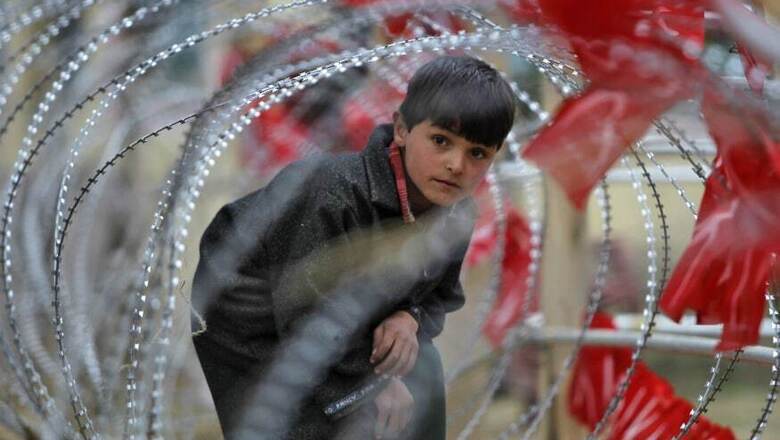
views
During the recent Raisina Dialogue in Delhi, the newly appointed Chief of Defence Staff, General Bipin Rawat, spoke on a range of issues. One of his comments was on radicalisation in Kashmir. He spoke about 12-year old children being radicalised, and his prescription was that some of them needed to be put in de-radicalisation camps similar to those in Pakistan. A few days later, the Jammu and Kashmir Director General of Police supported the idea of de-radicalisation camps as a “good development”.
Radicalisation is not a new term but, in recent times, has acquired a new character. After 9/11, the western nations suffered a rude shock to their concept of an inclusive, integrated society where nationalistic feelings were the uniting force of all sections of the population. The terror attacks in Madrid in 2004, London in 2005 and Boston in 2013 were not by outsiders but home-grown terrorists.
In searching for answers, these attacks were attributed to a bunch of misguided youth who had become radicalised due to an extreme religious conviction. Radicalisation thereafter became a buzzword synonymous with terrorism.
For the past few years, there is increasing talk in India that radicalisation is the reason for all our problems in Kashmir and that de-radicalisation will provide all the solutions. There is no doubt that a large number of Kashmiri youths are radicalised, but in tackling this issue there are no simplistic remedies.
The first thing we must grapple with is to define radicalisation. A report prepared by the European Commission's Expert Group on Violent Radicalisation, Radicalisation Processes Leading to Acts of Terrorism, states that “the term “radicalisation” is problematic in that its relationship to “radicalism” as an expression of legitimate political thought is confusing… As an ideology, radicalism challenges the legitimacy of established norms and policies but it does not, in itself, lead to violence”.
The problem, therefore, is not the radicalisation but where such radicalisation leads to recourse to violence. Several countries and the United Nations have adopted the term ‘preventing or countering violent extremism’ as the central plank of their strategy. Preventing violent behaviour is seen as more important than suppressing ideological differences.
Two other common misconceptions need to be busted. The first is that radicalisation is primarily religious. The minute we put one ideological factor above all others, we completely ignore the local issues. The Expert Group report notes that “although a number of contributing factors may be singled out as facilitators for the emergence of radicalisation processes leading to terrorism, it is impossible to identify one single root cause…precipitant factors vary according to each individual experience of and pathway to radicalisation.”
These precipitant factors could be “historical antecedents of political violence”, “excessive repression by state authorities", "alienation," or "perception of discrimination". These create a climate in which recourse to violence becomes the preferred path.
One more interesting finding of the report was that there are “remarkable similarities between radicalisation to current Islamist or jihadist terrorism and radicalisation associated with left-wing, right-wing or ethno-nationalist terrorism in Western Europe since the 1960s”.
The second misconception is that the internet is the primary cause of radicalisation. This argument has been the reason for the continuing denial of the internet in Jammu and Kashmir for the last five months. Two months ago, a report in the The Economic Times quoted officials as saying that the suspension of the internet has resulted in a dip in terror recruitment.
It is a certainty that the internet provides a somewhat secure and anonymous space where radical content and propaganda can be swiftly disseminated. Terrorist groups have been successfully using this medium for running a sophisticated online campaign. However, the role of the internet in radicalisation is often overstated. A 2016 German study on their citizens who left their country to join terror organisations in Iraq and Syria noted that “in most cases the internet played no major role. Only a few individuals were purely radicalised online”.
There is a similar finding in a 2017 United Nations Office of Counter-Terrorism report on foreign terrorist fighters in Syria. It states that "friendship circles and social networks are the most dynamic and powerful mechanism through which recruitment occurs, with the internet playing a far less significant role as an independent source of radicalisation than is generally assumed, and certainly a far less significant role than real life contact”.
Since radicalisation is a highly individual process, ideas like putting young people from one community in de-radicalisation camps are not only likely to raise communal fears, but also have little chance of achieving any real success. Picking up young children on the suspicion that they may join terrorist ranks in the future and sending them to camps is only a recipe for greater radicalisation.
If we have to resort to collective de-radicalisation, it could be attempted in prisons that house terrorists who have already taken the path to violence.
So how do we approach the problem of radicalisation among the Kashmiri youth? The focus should be more on disengagement rather than de-radicalisation. And a brief explanation of the two terms is necessary. A Rand Corporation study, Deradicalising Islamic Extremists, describes disengagement as a “change in behaviour (i.e., refraining from violence and withdrawing from a radical organization) but not necessarily a change in beliefs. ... Deradicalisation is the process of changing an individual’s belief system, rejecting the extremist ideology, and embracing mainstream values.”
With what has happened in Kashmir after August 5, the focus should be on ensuring that the youth do not resort to violence. It is impractical to hope that we can immediately change their beliefs that have strengthened through three decades of conflict.
The start point for any disengagement programme will have to be the correct identification of the drivers that push the youth towards violent extremism. Issues of identity, a sense of alienation, perceived injustice, economic empowerment, and good governance will have to be addressed holistically. This would require outreach to the youth, a strengthening of civil society efforts, and a government narrative that focuses not merely on development but on the human needs of a society that is feeling ostracised.
The government’s effort should also include a reining in of any form of extremist content on social media that paints all the Kashmiris as terrorists and anti-nationals. Such messaging only strengthens the radicals in Kashmir.
Radicalisation is a real and live issue in Kashmir, but we would do well to remember that off-the-cuff solutions will only exacerbate the problem.
(The author is former Northern Commander, Indian Army, under whose leadership India carried out surgical strikes against Pakistan in 2016. Views are personal.)














Comments
0 comment